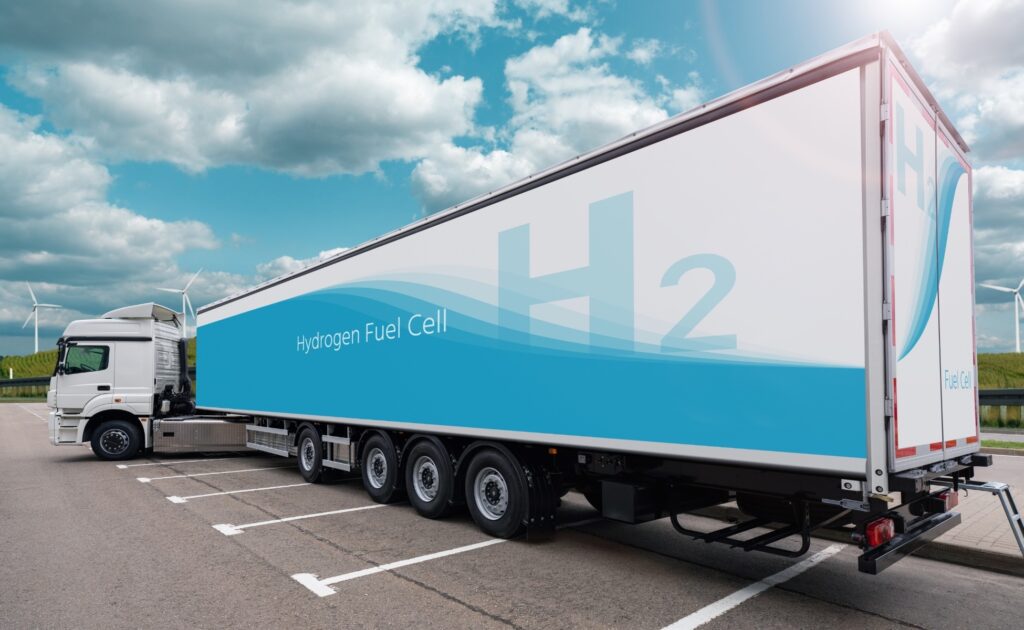
Hydrogen powered vehicles have long been hyped as an ideal clean alternative to gasoline powered engines but have never been widely adopted by commercial vehicles. Hydrogen-powered commercial vehicles, particularly hydrogen fuel cell vehicles (FCVs), represent an emerging technology in the transportation sector aimed at reducing emissions and dependency on fossil fuels.
Key Benefits of Hydrogen FCVs
- Zero Emissions: Vehicles using hydrogen as fuel combine oxygen from the air in a fuel cell to generate electricity, powering an electric motor and producing water vapor and heat as the only byproducts.
- Quiet Operation: FCVs operate far more quietly than traditional internal combustion engines, which is especially advantageous in dense urban or residential areas.
- Long Range and Quick Refueling: Hydrogen fuel cell vehicles typically offer longer ranges than battery electric vehicles, and refueling is fast, similar to gasoline vehicles taking only minutes.
- Right for Commercial Vehicles: FCVs are particularly well-suited for commercial applications due to their long range capabilities making them viable for all-day deliveries or long-haul transportation.
- Environmentally Conscious Image: Quiet FCVs can enhance the brand and image of delivery companies among customers concerned with sustainable business practices.

FCVs Have Not Been Widely Adopted
While natural gas produces about half the carbon emissions when burned than coal does, studies have shown how methane leaks throughout the supply chain are the source of considerable greenhouse gas emissions (Source: IEA, Environmental Defense Fund). For hydrogen fuel to be more widely adopted as a clean energy source, leaks in the infrastructure, releasing methane, must be resolved. Cleaner hydrogen is also more expensive to produce and has no nationwide distribution network. Most importantly, for commercial drivers, there is a limited availability of hydrogen refueling stations and infrastructure, existing today in concentrated markets like California or the Northeast.
Change May Finally Be Coming
Recent government policy may change and incentivize the development of hydrogen fuel cell vehicles:
- In October 2023, the Biden administration awarded $7 billion from the 2021 Bipartisan Infrastructure Law to establish seven regional hubs for hydrogen production.
- In December 2023, the U.S. Treasury Department proposed rules for the Hydrogen Production Credit allowing companies to claim tax credits for clean hydrogen production under the Inflation Reduction Act (IRA).
- The IRA also provides tax incentives for hydrogen fuel cell vehicles, hydrogen infrastructure, and storage.
Hydrogen FCVs make sense for long-haul trucking and round-the-clock freight logistics operations. GM is working with Autocar Industries to develop a line of hydrogen-powered heavy utility trucks including cement mixers, dump trucks, and garbage trucks.
Other truck manufacturers are also bringing commercial fuel cell trucks to market, including Toyota, Hyundai, and startup Nikola.
Cummins – a producer of diesel engines for all the major heavy-duty commercial truck brands including Freightliner, International, Kenworth, Mack, Peterbilt, Volvo, and Western Star – is now developing two hydrogen-fueled internal combustion engines (ICEs). Rivals Daimler Truck and Volvo Group have also joined forces on a new hydrogen fuel cell venture called Cellcentric with operations planned to start in 2025.
All of this business development and government support is encouraging to Bill Elrick, Executive Director of the Hydrogen Fuel Cell Partnership. “Up until two years ago, I knew we were in an uphill battle…I think something has shifted.”
Overall, hydrogen-powered commercial vehicles have the potential to play a significant role in decarbonizing the transportation sector, particularly for heavy-duty applications where long ranges and short refueling times are essential; in urban areas where noise pollution reduction may be a priority; and in operations where shippers have a major play at sustainability initiatives and reducing greenhouse gas emissions. However, addressing infrastructure, cost, and production challenges is crucial for realizing the potential for cleaner transportation solutions.











